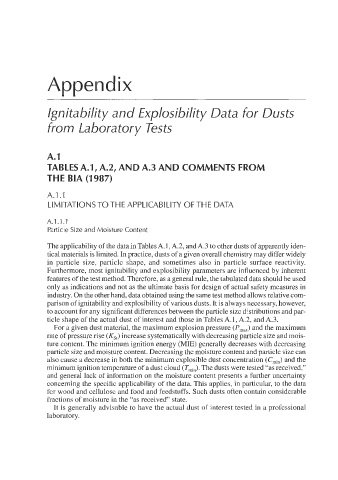Page 714 - Dust Explosions in the Process Industries
P. 714
Appendix
lgnitability and Explosibility Data for Dusts
from Laboratory Tests
A. 1
,,A.2, AND A.3 AND COMMENTS FROM
THE BIA (1987)
A.1-1
LIMITATIONS TO THE APPLICABILITY OF THE DATA
A.l .I .I
Particle Size and Moisture Content
The applicability of the data in Tables A. 1,A.2, and A.3 to other dusts of apparently iden-
tical materials is limited.In practice, dusts of a given overall chemistry may differ widely
in particle size, particle shape, and sometimes also in particle surface reactivity.
Furthermore, most ignitability and explosibility parameters are inff uenced by inherent
featuresof the test method. Therefore,as a general rule, the tabulated data should be used
only as indications and not as the ultimate basis for design of actual safety measures in
industry. On the other hand, data obtainedusing the same test method allows relative com-
parison of ignitabilityand explosibility of various dusts. It is always necessary,however,
to account for any significant differencesbetween the particle size distributionsand par-
ticle shape of the actual dust of interest and those in Tables A. 1,A.2, and A.3.
ust material, the maximum explosion pressure (Pmax)and the maximum
rate of pressure rise (KSJincrease systematicallywith decreasingparticle size and mois-
ture content. The minimum ignition energy (MIE) generally decreases with decreasing
particle size and moisture content. Decreasingthe moisturecontent and particle size can
also cause a decrease in both the minimum explosible dust concentration (e,,) and the
minimum ignition temperature of a dust cloud (T~,).The dusts were tested “as received,”
and general lack of information on the moisture content presents a further uncertainty
concerning the specific applicability of the data. This applies, in particular, to the data
for wood and cellulose and food and feedstuffs. Such dusts often contain considerable
fractions of moisture in the “as received” state.
It is generally advisable to have the actual dust of interest tested in a professional
laboratory.

